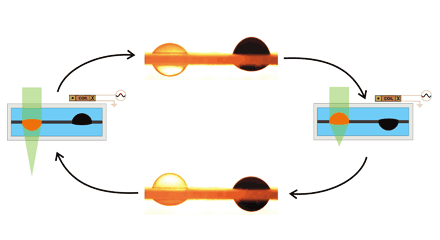Liquid Pistons May Pave the Way for Next-Gen Drug Delivery, Imaging, and Lab-on-a-Chip Applications
January 17, 2011
|
Liquid pistons can act as a liquid resonator, a pump, or as a camera. Image: Rensselaer Polytechnic. |
Liquid pistons could be exploited to develop a range of next-generation medical applications that include microdisplacement pumps, liquid switches, implantable eye lenses, imaging systems, and advanced drug-delivery platforms. The pistons are tunable, scalable, and suffer no wear and tear.
"It is possible to make mechanical pumps that are small enough for use in lab-on-a-chip applications, but it's a very complex, expensive proposition," says Amir Hirsa, a professor in the Department of Mechanical, Aerospace, and Nuclear Engineering at Rensselaer Polytechnic Institute (Troy, NY). "Our electromagnetic liquid pistons present a new strategy for tackling the challenge of microscale liquid pumping. Additionally, we have shown how these pistons are well-suited for chip-level, fast-acting adaptive liquid lenses."
Two ferrofluid droplets are housed in their own holes on a miniature substrate. Comprising the liquid piston, this structure is then place in a water-filled chamber. "Pulses from an electromagnet provoke one of the ferrofluid droplets, the driver, to vibrate back and forth. This vibration, in turn, prompts a combination of magnetic, capillary, and inertial forces that cause the second droplet to vibrate in an inverted pattern. The two droplets create a piston, resonating back and forth with great speed and a spring-like force. Researchers can finely control the strength and speed of these vibrations by exposing the driver ferrofluid to different magnetic fields," according to a Rensselaer press release.
In this capacity, the liquid piston serves as a liquid resonator; however, it can also act as a pump, the researchers note. This latter functionality could allow for timed drug-release in implantable devices. Furthermore, the liquid pistons can be employed as a miniature camera lens by passing light through the shape-shifting droplets. Testing of this capability showed that the speed and quality of video captured in this manner surpassed 30 Hz, which is comparable to the quality of a Webcam.
You May Also Like

.png?width=300&auto=webp&quality=80&disable=upscale)

